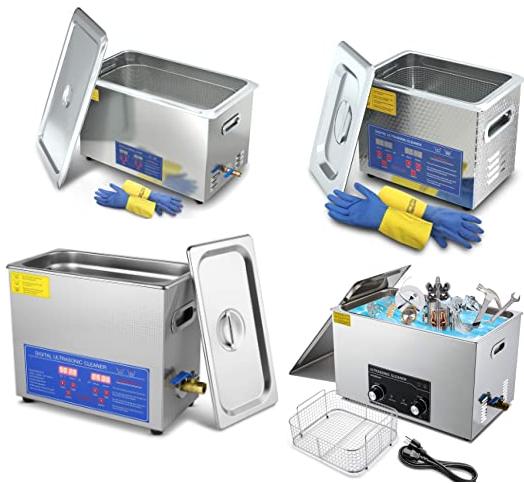Mechanical Gemstone Cleaning Perils arise from the structural weakness, fissures, fractures, fillings and inclusions of a gemstone.
Mechanical cleaning systems comprise ultrasonic, steam and boiling appliances. They offer you an intrinsic advantage. You are able to wash down difficult-to-clean gems set in jewelry effortlessly.
Nevertheless, if you opt for such cleaning methods, you should get it done by experts. Preferably, they should have liability insurance to cover accidental damage to your precious gemstones.
Pray, why should it be left to specialists?
It is because mechanical gemstone cleaning comes along with its own intrinsic risks. The hazards are born out of the structure and peculiarities of individual gemstones. Certain physical characteristics are unique to each particular gemstone. These might come in the form of inclusions, tiny fractures or structural weaknesses. Moreover, chemical composition and enhancement treatments if any, add their own woes if mechanical cleaning is undertaken.
Professionals take all these factors into account while selecting the method of cleaning. At the same time they are well-conversant with the precautions to be taken during the cleaning process.
Discussing The Risk Factors:
We all know that emeralds are the green versions of mineral Beryl. Now, beryl is a fairly hard mineral with a hardness of 7.5 to 8. But then, natural emeralds have a propensity to be full of cracks and fissures. As such, they are treated by immersing them in colorless oil or resin. This is done to fill up the fissures and enhance clarity & durability. This is an accepted practice in gem trade as long as it is openly declared.
The vibrations of mechanical cleaning could aggravate the cracks and fissures of this magnificent gemstone. It could mar the beauty of the gemstone or even fragmentize it.
Cleavage planes lurk within the crystalline structure of a topaz that appears flawless. It is a completely natural phenomena that occurs naturally even in diamonds. You must know that jewelers press the prongs of a prong set topaz jewel directly onto these cleavage planes. When vibrations of mechanical cleaning resonate with the pressure of a prong, the gemstone slices cleanly like a knife through butter. Sudden temperature change produces a similar result.
Diamond being the hardest material on our planet, does not cleave as easily. But the vulnerabilities of cleavage are hiding out here too. There are known incidents of a diamond shattering in an ultrasonic machine. Apart from cleavage planes, invisible liquid inclusions too can expand on heating and cause such mishaps.
Ultrasonic Cleaning
Mechanical Gemstone Cleaning Machine
Click On The Image
Ultrasonic cleaning systems are small machines whose main component is a stainless steel tank. This tank is filled with a special cleaning solution as per instructions in the manual. The jewels are placed in this solution and the machine is turned on.
As the device kicks into motion, you notice the ultrasonic vibrations churn the liquid and foment it into agitated bubbles. Most machine models also heat up the liquid. The heat and pressure thus created remove the built up grime from the jewelry.
Rhythmic pulsations from the machine get focussed on the hardest objects in the tank. In this case they are your jewelry pieces and gemstones. If there is a nascent cleave in your gemstone the concentrated energy can aggravate it and may even cause it to crack.
Furthermore, gems like emeralds, sapphires and ruby are treated with oils to improve transparency and color. Vibrations and churning bubbles of the ultrasonic machine can displace the oils out of the gems. It can make them look dull and lifeless.
Opals, pearls, emeralds, tanzanites, corals, turquoise, malachite and amber should never be subjected to ultrasonic cleaning. Among metals, tungsten jewelry should not be ultrasonically cleaned.
Some Precautions to minimise the Mechanical Gemstone Cleaning Perils:
Don’t let your jewelry touch the bottom or sides of the tank during the cleaning process. Rather, find a way to suspend them in the liquid, maybe by hanging them with a strong string or holding them with a pair of tweezers.
Monitor the temperature of the liquid. Too much heat can again damage your gemstones. Check the settings of the stone before and after cleaning to see that they are firmly in place. Vibrations can dislodge the stones from their settings. Use only specially formulated jewelry cleaning solutions for the purpose.
Steam Cleaning and Boiling
High temperature steam is a very efficient cleaning agent. It melts the oil and grease from the accumulated grime and blows all the dirt away. Boiling water also cleans the dirt effectively for similar reasons.
But once again, both steam and boiling water come with inherent risks. Rapid heating followed by rapid cooling is a recipe for the gemstone to crack. Uneven heating can cause a similar disaster.
Gemstones with oil fillings can lose their oils and deteriorate in looks. Stones with inclusions of different heat coefficients can expand and contract at a rate different to that of the gem. This can again cause the gemstone to crack.
Precautions to be taken during steam cleaning and boiling:
Submerge your gems in progressively warm, warmer and hot water instead of suddenly exposing them to scalding steam. Similarly, cool them gradually by submerging them in hot, warmer and warm water instead of directly putting them in cold water or exposing them to cold air.
Whenever you take your jewels to a professional cleaner, ask them pointed questions about their cleaning methods. Ask them how their methods are suitable for your jewel. Give them the job only if you are satisfied with their answers.
